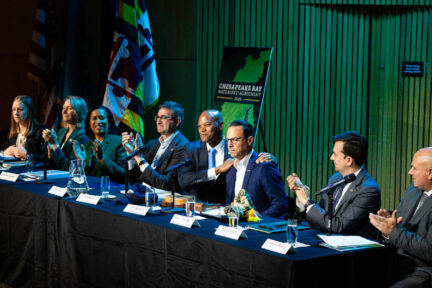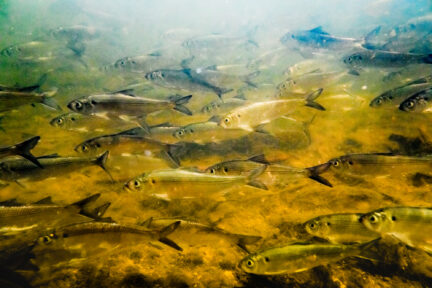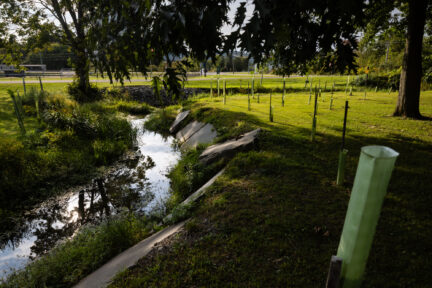Chesapeake Bay’s underwater grass abundance rises 27 percent in 2014
The 75,835-acre total is 41 percent of the goal set forth in the Chesapeake Bay Watershed Agreement.
Between 2013 and 2014, underwater grass abundance in the Chesapeake Bay rose 27 percent. The 75,835-acre total is 41 percent of the goal set forth in the Chesapeake Bay Watershed Agreement: to restore 185,000 acres of underwater grasses Bay-wide.
Scientists attribute this boost in bay grasses to the rapid expansion of native widgeongrass in moderately salty waters, even in areas where vegetation has not been observed before. Scientists have also observed a modest recovery of eelgrass in very salty waters, where the hot summers of 2005 and 2010 led to dramatic diebacks. The Susquehanna Flats remain the largest grass bed in the Bay, and aquatic vegetation continues to return to the areas impacted in 2011 by Hurricane Irene and Tropical Storm Lee.
The Chesapeake Bay Program tracks underwater grass abundance as an indicator of Bay health. Annual acreage is estimated through aerial surveys flown from late spring to early fall. Abundance is mapped in four different salinity zones, each of which is home to an underwater grass community that responds differently to strong storms, drought and other growing conditions.
Facts
Between 2013 and 2014, underwater grass abundance in the Chesapeake Bay increased 27 percent from 59,711 acres to 75,835 acres. This marks a 41 percent achievement of the 185,000-acre goal. Over the last two decades, underwater grass abundance has fluctuated between 38,958 acres (1984) and 89,659 acres (2002), averaging 65,806 acres.
Tracking Bay Grass Abundance by Salinity Zone:
- Between 1984 and 2014: Bay grass abundance in the Bay’s fresh waters (the Tidal Fresh Salinity Zone) has ranged from 6,900 acres (1995) to 25,481 acres (2008), averaging 12,496 acres. Between 2013 and 2014, bay grass abundance in this zone increased 1,320 acres to 15,305 acres, achieving 74 percent of the zone goal.
- Bay grass abundance in the Bay’s slightly salty waters (the Oligohaline Salinity Zone) has ranged from 653 acres (1984) to 13,919 acres (2005), averaging 6,705 acres. Between 2013 and 2014, bay grass abundance in this zone increased 1,800 acres to 7,413 acres, achieving 72 percent of the zone goal.
- Bay grass abundance in the Bay’s moderately salty waters (the Mesohaline Salinity Zone) has ranged from 15,636 acres (1984) to 48,444 acres (2002), averaging 28,159 acres. Between 2013 and 2014, bay grass abundance in this zone increased 11,850 acres to 37,260 acres, achieving 31 percent of the zone goal.
- Bay grass abundance in the Bay’s very salty waters (the Polyhaline Salinity Zone) has ranged from 9,959 acres (2006) to 24,016 acres (1993), averaging 17,818 acres. Between 2013 and 2014, bay grass abundance in this zone increased 1,154 acres to 15,857 acres, achieving 47 percent of the zone goal.
Issues
Like grasses on land, underwater grasses, also known as submerged aquatic vegetation or SAV, need sunlight to survive. When the waters of the Chesapeake Bay become clouded with algae blooms or suspended sediment, sunlight cannot reach the bottom habitat where grasses live. While healthy grass beds can trap and absorb some nutrient and sediment pollution—thus improving water clarity where they grow—too much pollution can cause grass beds to die off. Water temperatures, strong storms and drought can also affect the growth and survival of underwater plants. Chesapeake Bay Program partners are working to improve water clarity, protect existing grass beds and enhance bay grass-related education and outreach to restore underwater grasses in the watershed.
Importance
Underwater grass beds are critical to the Chesapeake Bay ecosystem. They offer food to small invertebrates and migratory waterfowl, and shelter young fish and blue crabs. Bay grasses also keep our waters clear and healthy by absorbing excess nutrients, trapping suspended sediment and slowing wave action and shoreline erosion.
Because bay grasses are sensitive to pollution but quick to respond to water quality improvements, their abundance is a good indicator of Bay health. To support the resurgence of underwater grass beds in the Bay, cities and towns can reduce polluted runoff and upgrade wastewater treatment plants with pollution-reducing technologies, farmers can use best management practices to keep fertilizers in their fields, boaters can steer clear of bay grass beds that are growing in shallow waters and homeowners can use rain barrels or rain gardens to slow nutrient- and sediment-laden stormwater runoff.
Quotes
“It is always impressive to see these underwater grasses spread and grow. This data offer hope to those of us who have watched these grasses decline in our lifetime: as efforts to clean up the Chesapeake Bay continue, these plant populations can rapidly recover. We cannot give up on our efforts to improve water quality, because there are plants and animals that depend on us to make this happen.”
--- Robert J. Orth, Professor of Marine Science and Coordinator of the Submerged Aquatic Vegetation Survey, Virginia Institute of Marine Science
“Improvements like these should give us all a renewed sense of dedication to restore the Chesapeake Bay ecosystem; these data are evidence that it’s possible. Every additional acre of underwater grasses measured in 2014 indicates improved water clarity and improved wildlife habitat. This shows that restoration efforts are working and, if we stay the course, we could be successful in reaching our long-term goals. These data also highlight the importance and value of the Submerged Aquatic Vegetation monitoring program. Without it, measuring our progress towards a restored Bay would be infinitely more difficult, so I thank the Virginia Institute of Marine Science for providing such vital information.”
--- Brooke Landry, Natural Resources Biologist, Maryland Department of Natural Resources and Chair, Chesapeake Bay Program’s Submerged Aquatic Vegetation Workgroup
“Underwater grasses are a key element of the Chesapeake Bay ecosystem. These grasses provide food and habitat for spawning and juvenile fish, and their health depends on water clarity. It is encouraging to see such a significant increase in underwater grass acreage and the continued recovery from the damage that occurred in 2011 after Hurricane Irene and Tropical Storm Lee. These underwater grasses are essential for building resilience into the Bay environment.”
--- Nick DiPasquale, Director, Chesapeake Bay Program



